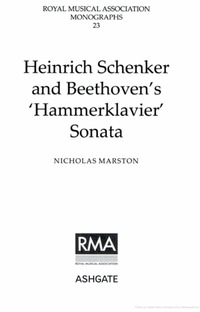- Work (Individual)
- RISM
- 1818
- English
- Beethoven, Ludwig van (1770-1827)
- Musical Work
- Große Sonate für das Hammerklavier | Hammerklavier
-
- Q146730 ⟶ Click Here
-
- 186299955 ⟶ Click Here
-
-
Ludwig van Beethoven's Piano Sonata No. 29 in B♭ major, Op. 106 (known as the Große Sonate für das Hammerklavier, or more simply as the Hammerklavier) is a piano sonata that is widely viewed as one of the most important works of the composer's third period and among the greatest piano sonatas of all time. Completed in 1818, it is often considered to be Beethoven's most technically challenging piano composition[1] and one of the most demanding solo works in the classical piano repertoire.[2][3] The first documented public performance was in 1836 by Franz Liszt in the Salle Erard in Paris.
Dedicated to his patron, the Archduke Rudolf, the sonata was written primarily from the summer of 1817 to the late autumn of 1818, towards the end of a fallow period in Beethoven's compositional career. It represents the spectacular emergence of many of the themes that were to recur in Beethoven's late period: the reinvention of traditional forms, such as sonata form; a brusque humour; and a return to pre-classical compositional traditions, including an exploration of modal harmony and reinventions of the fugue within classical forms.
The Hammerklavier also set a precedent for the length of solo compositions (performances typically take about 40 to 50 minutes, depending on interpretative choices). While orchestral works such as symphonies and concerti had often contained movements of 15 or even 20 minutes for many years, few single movements in solo literature had a span such as the Hammerklavier's third movement.
⟶ Wikipedia
-
Beethoven, Ludwig van (1770-1827) [Compose]. Sonatas, piano. no. 29, op. 106, | B♭ major
Beethoven, Ludwig van (1770-1827) [Compose]. Sonatas, piano. no. 29, op. 106, | B♭ major
Sonaten Klavier op. 106 | B-Dur (German) | Sonates, piano, no 29, op. 106, | si bémol majeur (greek)
Αvailable digital documents
 Incipit of the Piano Sonata No. 29 (Beethoven) in B-flat major, Op. 106. (Große Sonate für das Hammerklavier).
Incipit of the Piano Sonata No. 29 (Beethoven) in B-flat major, Op. 106. (Große Sonate für das Hammerklavier).
Description: 1280px-Sonata_No._29_1st_Movement (1).png (png) More information
Size: 115 kB Incipit of the 2th movement from the Piano Sonata No. 29 (Beethoven) in B-flat major, Op. 106
Incipit of the 2th movement from the Piano Sonata No. 29 (Beethoven) in B-flat major, Op. 106
Description: 1280px-Sonata_No._29_2st_Movement.png (png) More information
Size: 134 kB Incipit of the 3th movement from the Piano Sonata No. 29 (Beethoven) in B-flat major, Op. 106
Incipit of the 3th movement from the Piano Sonata No. 29 (Beethoven) in B-flat major, Op. 106
Description: 1280px-Sonata_No._29_3st_Movement.png (png) More information
Size: 142 kB
Subject of Work




